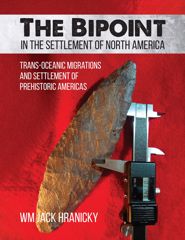
The Bipoint in the Settlement of North America
Trans-Oceanic Migrations and Settlement of Prehistoric Americas
by Wm Jack Hranicky

 View First 25 Pages:
View First 25 Pages:
 (free download)
(free download) Synopsis
This 378 page archaeological publication covers the development, definition, classification, and world-wide deployment of the lithic bipoint and includes numerous photographs, drawings, and maps. The bipoint is a legacy implement from the Old World that is found through time/space all over America. It was brought into the U.S. on both coasts; the Pacific Coast introduction was around 17,000 years ago and the Atlantic Coast was 23,000 years ago. The basic bipoint is defined and its manufacturing processes are presented along with bipoint properties, shape/form, resharpening, and cultural associations. This publication illustrates numerous bipoints from the Atlantic and Pacific states (and within the U.S.) and presents some of their inferred chronologies which are the oldest in the New World. Several morphologies between American and Iberian bipoints are compared, namely the famous Virginia Cinmar bipoint. It concludes that a Solutrean occupation did occur on the U.S. Atlantic coastal plain. The bipoint is the most misclassified artifact in American archaeology. The book is indexed and has extensive references.
About the Author
Jack Hranicky is a retired government contractor who has been involved with archaeology as a full-time passion for over 50 years. His main interest is the Paleo-Indian period, but he has worked in all facets of American archaeology. Mr. Hranicky taught anthropology at the Northern Virginia Community College and St Johns College High School and has published over 200 papers and over 50 books about archaeology. He has served as president of the Archeological Society of Virginia (ASV) and Eastern States Archeological Federation (ESAF), been past chairman of the Alexandria Archaeology Commission, and he is a charter member of the Registry of Professional Archaeologists (RPA). He runs the Virginia Rockart Survey and formerly the McCary Fluted Point Survey. He has honorary-life memberships in six Virginia historical societies. Also, Mr. Hranicky received Meritorious Service Awards from the U.S. State Department for his governmental work and the Smithsonian Institution for his anthropological work. He is currently overseeing 18 archaeological Pleistocene sites. His numerous books on prehistoric tools have made him a national authority in the U.S.




 View or Post a Review at Amazon.com
View or Post a Review at Amazon.com